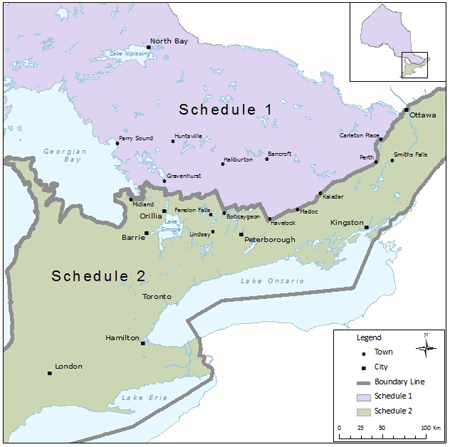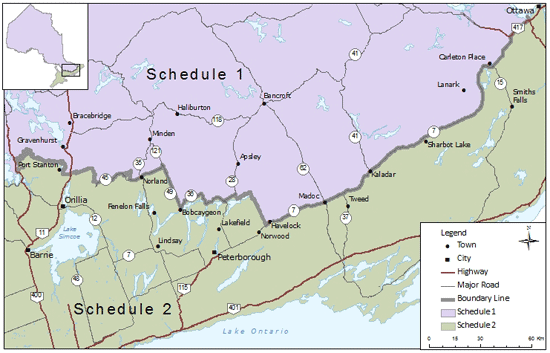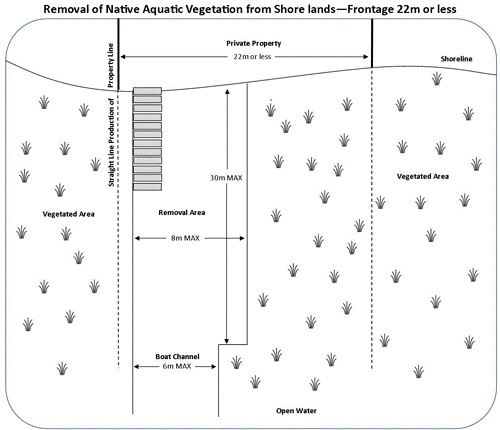Remove native aquatic plants
The rules for removing native aquatic plants that occur naturally in Ontario.
Effective June 1, 2017.
The basics
In Ontario, the beds of most water bodies are Crown land.
The ministry manages these lands under the Public Lands Act.
The Public Lands Act applies to the use of provincial Crown land and shore lands. There are some exceptions, including provincial parks and conservation reserves.
The Act does not apply to the use of federal lands and waterbodies (e.g., the Trent-Severn and Rideau Canal waterways).
You can remove native aquatic plants, if the property is located south of the line shown in the map below, provided you follow certain rules.
If the property is located north of the line shown in the map below, a work permit is always required.
Source law
This is a summary of the provincial laws. You can find a complete set of provincial rules under the act in:
Boundary line
Check the maps to make sure you will be working on property located south of the line shown in the map below.
If the property is located north of the line, you will need a work permit to proceed.
A work permit is also required for the shorelines of Georgian Bay and Lake Huron.


The rules
You do not need a work permit under the Public Lands Act, if you can follow all of these rules. You:
- only conduct work on property located south of the line shown in the map above
- are the waterfront property owner or conducting work on behalf of the property owner
- only conduct work on shore lands directly in front of your property or your client’s property
- dispose of the plants/material you remove on dry land to prevent it from re-entering the water
- use, operate or store any wheeled or tracked machinery/equipment on dry land, or on a barge or vessel
- only use mechanical devices (e.g., rake, cutter bar) or your hands to remove plants, and do not dredge the bed of the waterbody
- do not clear an area exceeding the following dimensions (see the following table)
| Frontage of property | Maximum removal dimensions | ||
|---|---|---|---|
| Width of main swimming/boating area | Length of main swimming/boating area | Width of boat channel | |
| More than 22 m | 15 m | 30 m | 6 m |
| Less than or equal to 22 m | 8 m | 30 m | 6 m |
- clear the same area up to a maximum of the dimensions in the table above if you have cleared an area in the past under a work permit or these rules, or someone has done this work on your behalf
- do not carry out work during fish spawning season or during the time of other critical life fish stages as set out in the In-water Work Timing Window Guidelines
See: In-water Work Timing Window Guidelines (PDF)
When you need a work permit
You will need a work permit to remove native aquatic vegetation, if you:
- want to conduct work on property north of the line shown in the map above
- can't meet all of the rules in this article
If you can't follow the rules, or work without a work permit when one is needed, you may be charged and fined.
How to get a work permit
To apply for a work permit:
- download and complete the Application for Work Permit Part 1 (PDF)
- download and complete Application to do Work on Shore lands Part 3 (PDF)
- include proof of ownership (e.g. deed)
- include sketches/drawings/survey plans indicating your property lines and where the work is taking place
- submit complete application by mail or in person to a local ministry office
Additional information may be required.
Waterfront property owners
You can only conduct work on shore lands directly in front of your property or where your property is fronted by a road allowance or shoreline reserve.
This diagram is for illustration purposes only.
You may also want to discuss the project with neighbours, before starting work.
Limits on area cleared
If the width of your waterfront is less than 22 metres, you cannot exceed the following dimensions when clearing the main area.

If the width of your waterfront is more than 22 metres, you cannot exceed the following dimensions when clearing the main area.

These diagrams are for illustration purposes only.
Herbicides
If you plan to use certain chemicals or substances to remove plants, you will need approval from the Ontario Ministry of the Environment and Climate Change.
Wild rice
Avoid removing wild rice.
Read: Wild Rice Harvesting Act
Report invasive plants
To report sightings, call the Invading Species Hotline:
Toll-free: 1-800-563-7711 or visit www.eddmaps.org/ontario to report on-line.
Identify invasive plants
Refer to the Field Guide to Aquatic Invasive Species to help identify the plants before you remove them.
Guide: how to identify invasive plants
Using machinery
Machinery should be kept in clean condition and free from fluid leaks.
Suspected contamination
If you suspect that the area could be contaminated, you should contact a local Ministry of the Environment and Climate Change Office.
Report a spill
To report a spill, call the Spills Action Centre at 1-800-268-6060.
Ottawa River
For properties along the Ottawa River, you must contact Infrastructure Ontario Property Services for more information:
- email: Infrastructure Ontario
- telephone: 1-877-863-9672
- fax: 416-325-4646
Related requirements
Before you start any work, find out whether additional authorizations are required.
For example, you may need to check with:
- local conservation authority
- Ontario Ministry of the Environment and Climate Change
- Fisheries and Oceans Canada
- Transport Canada
- local municipality/township
- Ministry of Natural Resources for endangered and protected species
- other provincial ministries
- Ontario One Call (to see if hydro/gas lines could be impacted)
Remember that removing plants does not give you any right, title or interest in the Crown land.